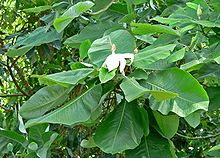Magnolia dealbata
| Magnolia dealbata | |
|---|---|

| |
| Scientific classification | |
| Kingdom: | Plantae |
| Clade: | Tracheophytes |
| Clade: | Angiosperms |
| Clade: | Magnoliids |
| Order: | Magnoliales |
| Family: | Magnoliaceae |
| Genus: | Magnolia |
| Subgenus: | Magnolia subg. Magnolia |
| Section: | Magnolia sect. Macrophylla |
| Species: | M. dealbata
|
| Binomial name | |
| Magnolia dealbata | |
| Synonyms[2] | |
| |
Magnolia dealbata is a species of flowering plant in the family Magnoliaceae, native to Mexico. It is known commonly as the cloudforest magnolia[3] and eloxochitl.[4] It is sometimes considered to be a subspecies of Magnolia macrophylla, which is otherwise native to the southeastern United States.[5]
Description
Magnolia dealbata is a deciduous tree, growing to average heights of 25 meters tall.[6] Larger individuals can reach 40 to 50 meters in height.[7] The flowers are large and white up to 20 cm long. Leaves are broad, reaching 50 cm in length.[6]
Distribution and habitat
This species is endemic to cloud forests in the mountains of eastern and south central Mexico. It typically grows at elevations of 1200 to 1500 meters (3,937 to 4,921 feet) above sea level, alongside Magnolia oaxacensis, Pinus chiapensis, Quercus laurina, Liquidambar styraciflua, and Clethra sp.[4][5]
Populations identified as M. dealbata in the Sierra Madre Oriental of Querétaro, Veracruz, Hidalgo, Nuevo Leon, Tamaulipas and San Luis Potosí correspond to more recently-described species including Magnolia nuevoleonensis, Magnolia rzedowskiana, and Magnolia vovidesii.[5]
The species was once thought to be extinct until being rediscovered in 1977.[8]
Etymology
The name eloxochitl was given to the tree by the Aztecs. It is derived from the Nahuatl word elotl meaning "green ear of corn", and xochitl meaning "flower".[4]
Uses
Magnolia dealbata is cultivated as an ornamental plant, used as a flowering tree in gardens.
It is also used for timber, and as a traditional medicinal plant for heart conditions, asthma, and stomach pain.[5][9] The flowers are used as decorations for spiritual and cultural events as well.[5]
References
- ^ Rivers, M.C. (2016). "Magnolia dealbata". IUCN Red List of Threatened Species. 2016: e.T88558975A2796189. doi:10.2305/IUCN.UK.2016-1.RLTS.T88558975A2796189.en. Retrieved 17 November 2021.
- ^ Plants of the World Online. Royal Botanic Gardens, Kew. 2022 http://www.plantsoftheworldonline.org/taxon/urn:lsid:ipni.org:names:. Retrieved 26 October 2022.
{{cite web}}: Missing or empty|title=(help) - ^ USDA, NRCS (n.d.). "Magnolia dealbata". The PLANTS Database (plants.usda.gov). Greensboro, North Carolina: National Plant Data Team. Retrieved 28 June 2015.
- ^ a b c Pattison, Graham (18 October 2022). "Magnolia Dealbata" (PDF). Magnolia Society.
- ^ a b c d e Rivers, M.C. 2016. Magnolia dealbata. The IUCN Red List of Threatened Species 2016: e.T88558975A2796189. https://dx.doi.org/10.2305/IUCN.UK.2016-1.RLTS.T88558975A2796189.en. Accessed on 9 August 2022.
- ^ a b Corral-Aguirre, Juan; Sánchez-Velásquez, Lázaro Rafae (12 April 2006). "Seed ecology and germination treatments in Magnolia dealbata: An endangered species". Flora - Morphology, Distribution, Functional Ecology of Plants. 201 (3): 227–232 – via ScienceDirect.
- ^ Grímsson, Friđgeir; Meller, Barbara; Bouchal, Johannes M.; Zetter, Reinhard (2015-04-03). "Combined LM and SEM study of the middle Miocene (Sarmatian) palynoflora from the Lavanttal Basin, Austria: part III. Magnoliophyta 1 – Magnoliales to Fabales". Grana. 54 (2): 85–128. doi:10.1080/00173134.2015.1007081. ISSN 0017-3134.
- ^ Vovides, A. P., & Iglesias, C. G. (1996). Seed germination of Magnolia dealbata Zucc.(Magnoliaceae), an endangered species from Mexico. HortScience, 31(5), 877-877.
- ^ Mata-Rosas, M., Jiménez-Rodríguez, Á., & Chávez-Avila, V. M. (2006). Somatic embryogenesis and organogenesis in Magnolia dealbata Zucc.(Magnoliaceae), an endangered, endemic Mexican species. HortScience, 41(5), 1325-1329.
 Media related to Magnolia dealbata at Wikimedia Commons
Media related to Magnolia dealbata at Wikimedia Commons
- IUCN Red List near threatened species
- Magnolia
- Endemic flora of Mexico
- Trees of Mexico
- Flora of Hidalgo (state)
- Flora of Oaxaca
- Flora of Veracruz
- Endangered biota of Mexico
- Endangered plants
- Garden plants of North America
- Ornamental trees
- Taxa named by Joseph Gerhard Zuccarini
- Flora of the Sierra Madre de Oaxaca
- Cloud forest flora of Mexico
- Magnoliales stubs

